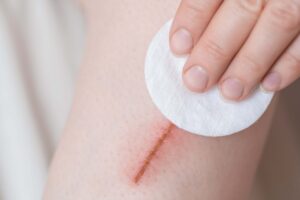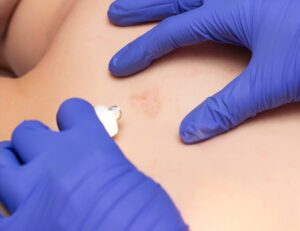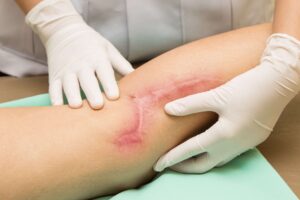Scars are a natural part of the body’s healing process that form in the final stage of wound healing referred to as the remodeling phase. Whether it’s from an accident, disease, or skin condition; there are a number of injuries that can result in a scar forming. While scars are a part of the body’s natural response and some can’t completely disappear, many wonder if there is anything that can be done to minimize their appearance.
It turns out, wound care and management can have a direct impact on how the skin recovers after an injury. By educating yourself on proper wound care techniques it is possible to minimize scarring and in some cases even prevent it entirely.
What Are Scars and How Do They Form
 When a wound damages the deeper level of the skin (also referred to as the dermis), your body grows tissue thicker than the surrounding skin, which in turn often results in a scar forming. Let’s dig a little deeper into this biological reaction.
When a wound damages the deeper level of the skin (also referred to as the dermis), your body grows tissue thicker than the surrounding skin, which in turn often results in a scar forming. Let’s dig a little deeper into this biological reaction.
After suffering an injury, the tissues in the skin brake and release a protein called collagen. As collagen builds up around the injury, it works to help strengthen and heal the wound. This process continues and blood supply increases causing a visible scar to form. The newly formed scar tissue will have a different texture than the skin around it. Unlike normal skin, scars consisting of collagen fiber are organized in a single direction. Over time, as collagen levels decrease the scar eventually becomes softer and less visible. While scars are permanent they can continue to fade over a couple of years.
Whether you get a scar can depend on a number of factors including:
- Location of the wound and how severe it is.
- How quickly the wound is treated.
- Underlying conditions that impair healing such as diabetes.
- Age and genetics.
- Signs of infection.
Different Types of Scars
There are several different types of scars depending on the cause of the injury and the response from the body. Some of the most common types of scars include:
- Fine Line Scars – These types of scars are common after a wound or surgery. They usually appear as a raised line that fades over time.
- Keloid Scars – When the body produces an excess amount of collagen it results in an overgrowth of tissue which can continue to grow even after the wound has healed.
- Hypertrophic Scars – Also caused when the body produces too much collagen. However, hypertrophic scars remain within the boundaries of the wound.
- Pitted scars – Caused when underlying fat or muscle supporting the skin is lost. They can also form after surgery or from certain skin conditions such as chickenpox or acne.
- Scar Contractures – Scar contractures often surface after a serious burn.
- Stretched Scars – Occurs when the skin stretches at a quicker rate than normal. For example when a wound occurs near a joint. Growth spurts or pregnancy can also result in these types of scars.
Wound Care Can Help Treat and Reduce Scars
 How your scar appears will often depend on how effectively the wound heals. Although scars caused by a wound near your joints or after surgery might be difficult to avoid, for more minor injuries you can help make scars less visible through proper wound care and management. Your wound care specialist can also help offer recommendations to treat your wound as a scar is forming.
How your scar appears will often depend on how effectively the wound heals. Although scars caused by a wound near your joints or after surgery might be difficult to avoid, for more minor injuries you can help make scars less visible through proper wound care and management. Your wound care specialist can also help offer recommendations to treat your wound as a scar is forming.
While complete scar removal might not be possible, there are a few treatment approaches for less serious wounds that can help make scars less noticeable:
- Start treatment as soon as possible after the wound occurs.
- Always keep the area clean by washing your hands and the area with soap and water to help avoid infection.
- Dry your skin with a paper town. Try to pat it and not rub it dry.
- Try using petroleum jelly or a similar ointment to keep the wound moist and prevent scabs that can delay healing. You can also ask a specialist for other options to keep the skin moist.
- Apply an adhesive bandage such as a band-aid, gauze, or silicone gel sheet to the injured area when you’re not cleaning or dressing the area.
- Remember to change the dressing every day to keep the area clean.
- If you needed stitches ask your wound care specialist or doctor for advice on caring for your wound and anything else that might minimize the scar.
Additional Wound Care Tips for Minimizing Scars
- Avoid scratching or picking scabs that can make it more likely to scar.
- Try to minimize movement and overexerting the area.
- Massaging the area regularly can also be helpful.
- Avoid exposing the wound to too much sun. Certain sunscreens may help the scar fade.
- If you have a scar that is still bothering you, skin camouflage or makeup specifically designed to cover scars can also help.
- It can take time for some scars to fade so remember to be patient.
When to See A Wound and Skin Care Specialist
While the above can be helpful for more minor wounds, for more serious skin injuries it’s better to play it safe and see a wound and skin specialist. In many cases, early intervention can be essential to healing wounds and influencing how a scar heals. A few examples of more serious skin injuries you might want to seek professional help for include:
- A cut that continues to bleed
- Deep puncture wounds
- Bites
- Serious Burns
- Any sign of infection after a skin wound
Alternative Treatment Options
 Over the past few years, there have been a number of advances in the treatment and prevention of scarring. A recent article published in Advances in Wound Care details the effectiveness of these options in greater depth. The paper concludes that the “treatment of scars with current individual or combination therapy can improve the appearance of scars”. For example, in some cases depending on the type of scar, you can ask a specialist about integrating alternative approaches with other treatments such as:
Over the past few years, there have been a number of advances in the treatment and prevention of scarring. A recent article published in Advances in Wound Care details the effectiveness of these options in greater depth. The paper concludes that the “treatment of scars with current individual or combination therapy can improve the appearance of scars”. For example, in some cases depending on the type of scar, you can ask a specialist about integrating alternative approaches with other treatments such as:
- Pressure therapy to help reduce or prevent scars
- Certain skin creams and topical treatments such as onion extract
- Steroids to help flatten the scar
- Low dose radiotherapy
- Dermabrasion or Microdermabrasion
- Laser therapy
- Microneedling
- Cryotherapy
Although not always recommended, in some severe cases, surgical options have been known to help depending on the type of scar.
If you have a scar that won’t fade over time or an injury you’re concerned might result in one, a healthcare professional that specializes in wound and skin care can help.
Specialized Wound and Dermatology Care
No matter how careful you are scars can happen and are common. While some scars might never completely disappear you can make sure your wound is healing effectively and reduce their appearance by consulting with the expert team at West Coast Wound Center. We provide a full suite of integrated wound and dermatology services for every patient that walks through our doors.
If you or a loved one have suffered a serious wound and are concerned about scarring, book an appointment today and find out how we can help restore your quality of life.
